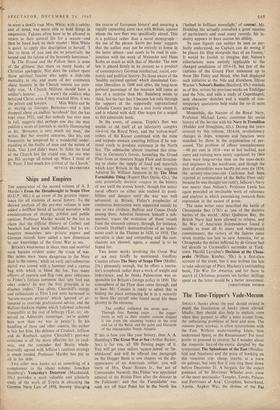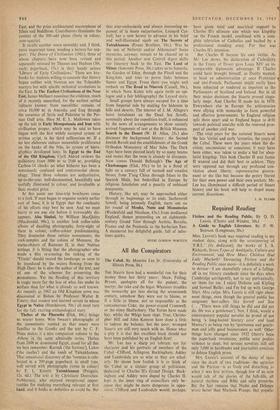The Time-Tripper's Vade-Mecum
IDEALLY, books about the past should extend in depth the fascination of books about abroad. Ideally, they should also help to explain, even when they purport to offer a mere escape from, the suffocating problems of here and now The remoter past, anyway, is often synonymous with the East. Without understanding Islam, how understand Spain, or the Renaissance? Yet most prefer to proceed in reverse. So I wonder about the romantic lure-of-the-exotic dangled by the symposium The Splendours of the East (Weiden- feld and Nicolson) and the price of booking on this vicarious trip: cheap, maybe, at a mere six guineas, but only five if you ring them down before December 31.. A bargain, for the expert guidance of Sir Mortimer Wheeler over some of the more spectacular 'Temples, Tombs, Palaces and Fortresses of Asia'; Ctesiphon, Samarkand, Ajanta, Angkor Wat, the shrines of the Far
East, and the prize architectural masterpieces of Islam and Buddhism. Contributors illuminate the context of the 300-odd plates (forty in colour, over-quarto).
It recalls another more unwieldy and, I think, more important tome, needing a lectern for sup-
port: The Dawn of Civilisation (1961); three of
whose chapters have now been revised and separately reissued by Thames and Hudson (30s, each; paperback, 15s.) in their handy octavo `Library of Early Civilisations.' These are key- books for students willing to concede that history began neither with Newton nor the Tolpuddle martyrs but with sPecific technical revolutions in the East. In The Earliest Civilisations of the Near East, James Mellaart examines the evidence, much of it recently unearthed, for the earliest settled cultures knOwn: from mesolithic remains of
circa 10,000' BC in Anatolia and Iraq through
the ceramics of Syria and Palestine to the Per- sian Gulf area. Here M. E. L. Mallowan takes
up the tale in Early Mesopotamia and Iran with civilisation proper, which may be said to have begun with the first widely accepted system of written script, in the third millennium BC. If a no less elaborate culture meanwhile proliferated on the banks of the Nile, its system of hiero- glyphics developed later. In Egypt' to the End of the Old Kingdom, Cyril Aldred reviews the prehistory from 5000 ac to 2160 tic, providing Carbon-14 checks on what hitherto has been a notoriously confused and controversial chron- ology. These three volumes are authoritative, up-to-the-year, well-documented, beautifully and usefully illustrated in colour, and invaluable at their modest price.
At this point our time-trip brochures come to a fork. If man began to organise society earlier east of Suez; it is in Egypt that the continuity of his efforts may best be seen. And we must hurry to see one site before it irrevocably dis- appears. Abu Simbel, by William MacQuitty (Macdonald, 90s.), is another lush coffee-table album of dazzling photographs, forty-eight of them in colour, coffee-colour predominating. They dramatise those outsize monuments, the rock-temples and the colossi of Memnon, the status-objects of Rameses II, in their Nubian settings. It is fitting that the photographer who made a film re-creating the sinking of the `Titanic' should record the landscape so soon to be inundated by the waters flowing from the High Dam: he is also the author of the text, and of one of the schemes for preserving the ,monuments. Yet the flooding of this territory is tragic more for the loss of what lies under its surface than for what is already so well known. As recently as 1962 an Old Kingdom town was discovered at Buhen by Professor Walter B. Emery, that modest and learned savant to whose Egypt in Nubia (Hutchinson, 50s.) all must turn for the full, exciting archaeological story.
Thebes of the Pharaohs (Elek, 84s.) brings us nearer home. Wim Swaan's photographs of the monuments remind us that many were familiar to the Greeks and the text by C. F. Nims makes it a nice companion volume to the Athens in the same admirable series. Thebes from 2100 BC dominated Egypt, stood for all that we best remember: Karnak (`the fortress), Luxor (`the castles') and the tomb of Tutankhamen. That sensational discovery of the 'twenties is cele, brated in a 200-page paperback in small type, well served with photographs (some in colour) by F. L. Kenett: Tutankhamen (Penguin, 12s. 6d.). The' text is by Christiane Desroches- Noblecourt, who enjoyed exceptional oppor- tunities for studying everything relevant at first hand, and it looks as definitive as could be. But that ever-enthusiastic and always interesting ex- ponent of la haute vulgarisation, Leonard Cot-
trell, has a new heresy to advance in his brief and well-illustrated squib on The Secrets of Tutenkhamen (Evans Brothers, 16s,). Was he the son of Nefertiti -and/or Ahkenaten? Some mysteries, anyway, remain to be cleared up in this period. Another new Cottrell digest shifts our itinerary back to the East. The Land of Shinar (Souvenir Press, 30s.) takes us.-to Sumeria, the Garden of Eden, through the Flood and the King-lists, and tries to prove links between Sumer and Egypt. From there you might well embark on The Road to Nineveh (Cassell, 36s.), in which Nora Kubie tells again (with an epi- logue and a fair bibliography) the Layard story.
Small groups have always escaped for a time from Imperial rule by making for hideouts in hills and deserts. The interest of J. M. Allegro's latest instalment on the Dead Sea .Scrolls, nominally about the expedition itself, is enhanced by the news of arrangements to show recently arrived fragments of text at the British Museum. Search in the Desert (W. H. Allen, 25s.) also discusses the background history : the Second Jewish Revolt and the establishment of the Greek Orthodox Monastery of Mar Saba. The Dark Ages have been pierced lately by so many beams and motes that the term is already in disrepute. Now comes Donald Bullough's The Age of Charlemagne (Elek, 95s.) to let in a flood of light on a century full of turmoil and creative throes, from T'ang China through Islam to the Spanish Main, but bedevilled in Europe by religious fanaticism and a paucity of unbiased documents.
History, like art, may be approached either through its beginnings or its ends. Sacheverell Sitwell, being intensely English, starts out on his round of Monks, Nuns and Monasteries (Weidenfeld and Nicolson, 63s.) from mediaeval England, thence proceeding on an eighteenth- ceritury Grand Tour through Austria, Bavaria, France and the Peninsula to the barbarian East. A mannered but delightful guide, full of infec- tious quirks.
HUGH GORDON PORTEUS































 Previous page
Previous page